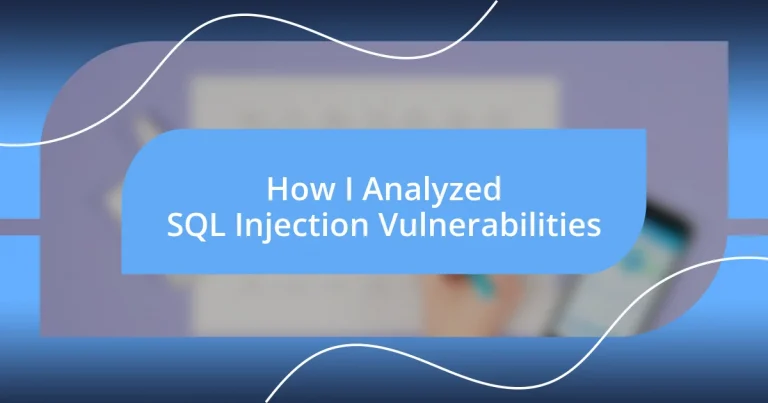Key takeaways:
- SQL injection is a critical security threat that exploits poorly validated user inputs to manipulate databases, highlighting the need for diligent input validation.
- Employing both automated tools like SQLMap and manual testing techniques is essential for effectively identifying and addressing SQL injection vulnerabilities.
- Implementing mitigation strategies, such as parameterized queries, regular input validation, and utilizing web application firewalls (WAFs), significantly reduces the risk of SQL injection attacks.
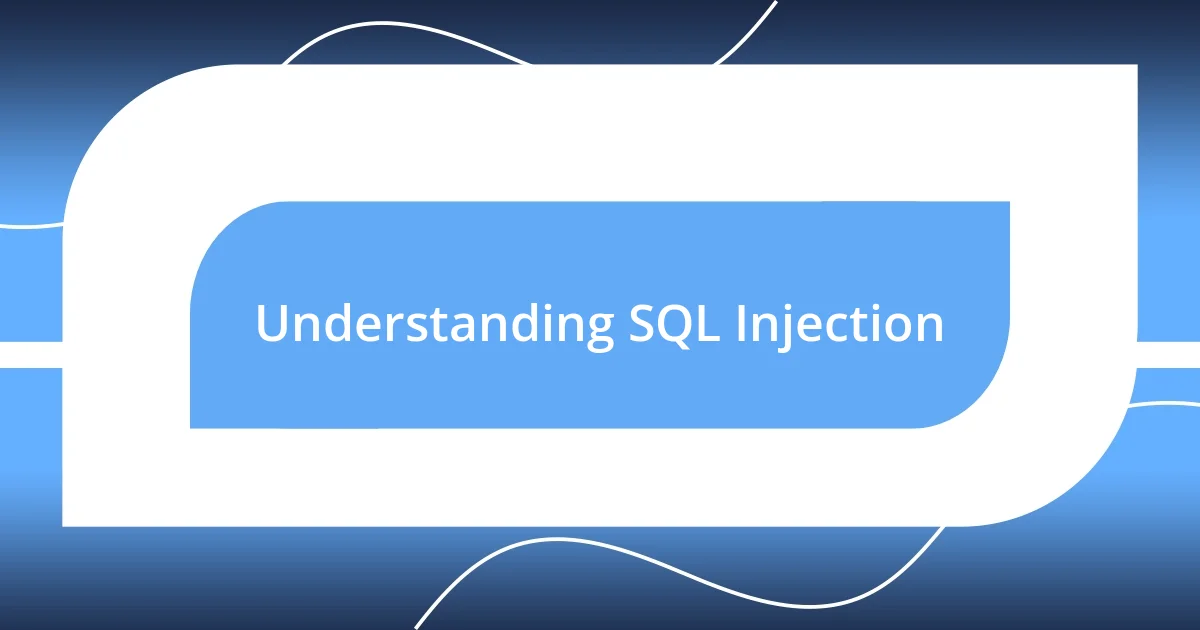
Understanding SQL Injection
SQL injection is a technique that allows attackers to manipulate a website’s database by inserting malicious SQL code into input fields, often exploiting vulnerabilities in poorly designed applications. Imagine the frustration I felt when I first encountered this issue while testing an online form; it hit me just how precarious our reliance on data can be. Why do so many applications overlook input validation when it serves as the first line of defense?
At its core, SQL injection occurs when user inputs are directly executed as queries in a database without proper sanitization. I remember a late-night debugging session where I was revisiting an old project; it was alarming to realize that a simple oversight could compromise sensitive user information. Can you see how a single careless mistake can leave the door wide open for an attacker?
The potential impact of SQL injection is staggering, ranging from unauthorized data access to complete system takeover. The most vivid illustration was when a colleague shared a story about a high-profile breach that stemmed from a simple SQL injection vulnerability. It made me ponder: how can we, as developers, ignore such an obvious threat in our pursuit to build robust applications?
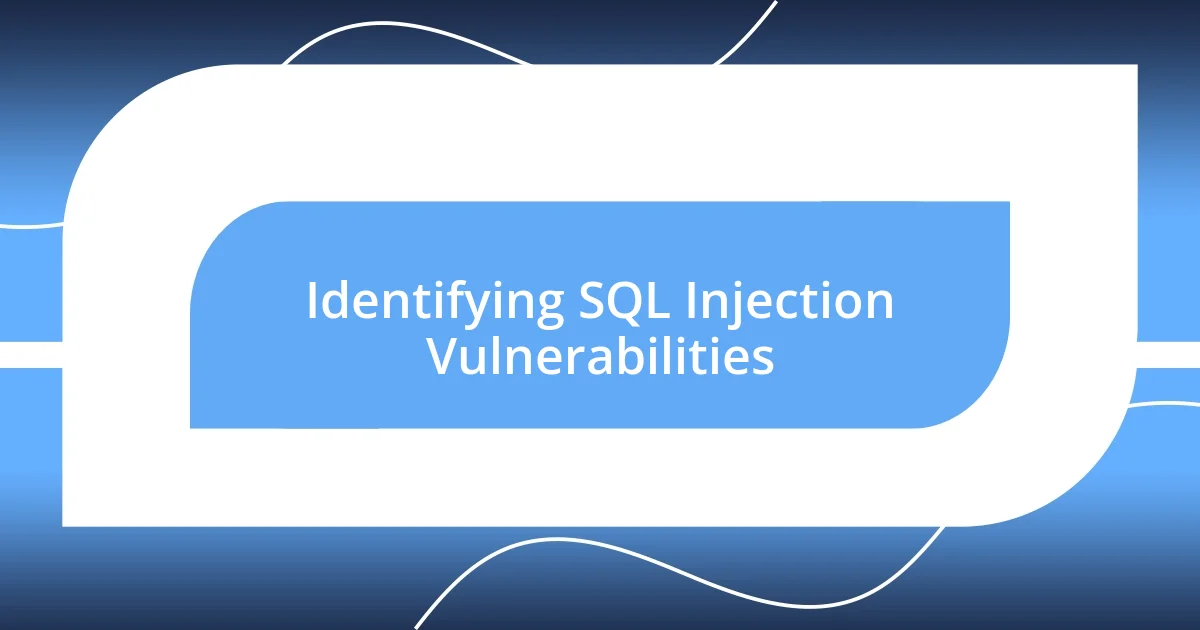
Identifying SQL Injection Vulnerabilities
Identifying SQL injection vulnerabilities requires a keen eye for detail and an understanding of how data interacts within applications. In my early days as a developer, I learned the hard way that overlooking small input fields could lead to significant consequences. While reviewing a web application, I stumbled upon a user authentication form that not only lacked the proper input validation but also inadvertently revealed its database structure through error messages. This moment cemented my belief in the importance of proactive vulnerability assessments.
To effectively identify these vulnerabilities, consider the following techniques:
– Input Validation Review: Consistently ensure all user inputs are properly sanitized before reaching the database.
– Error Message Analysis: Look for verbose error messages that might expose critical information.
– Automated Scanning Tools: Utilize tools like SQLMap or Burp Suite to simulate potential attacks.
– Manual Testing: Carefully manipulate input fields with SQL code snippets to observe unexpected behavior.
– Code Review: Regularly audit your application’s code for direct database queries that lack prepared statements or parameterized queries.
During one pen-testing session, my heart raced as I manipulated an input field, witnessing the immediate response in the application. It was both exhilarating and terrifying to know how simple tweaks could unearth vulnerabilities. This hands-on experience reinforced my understanding of the necessity for vigilance in the development process.
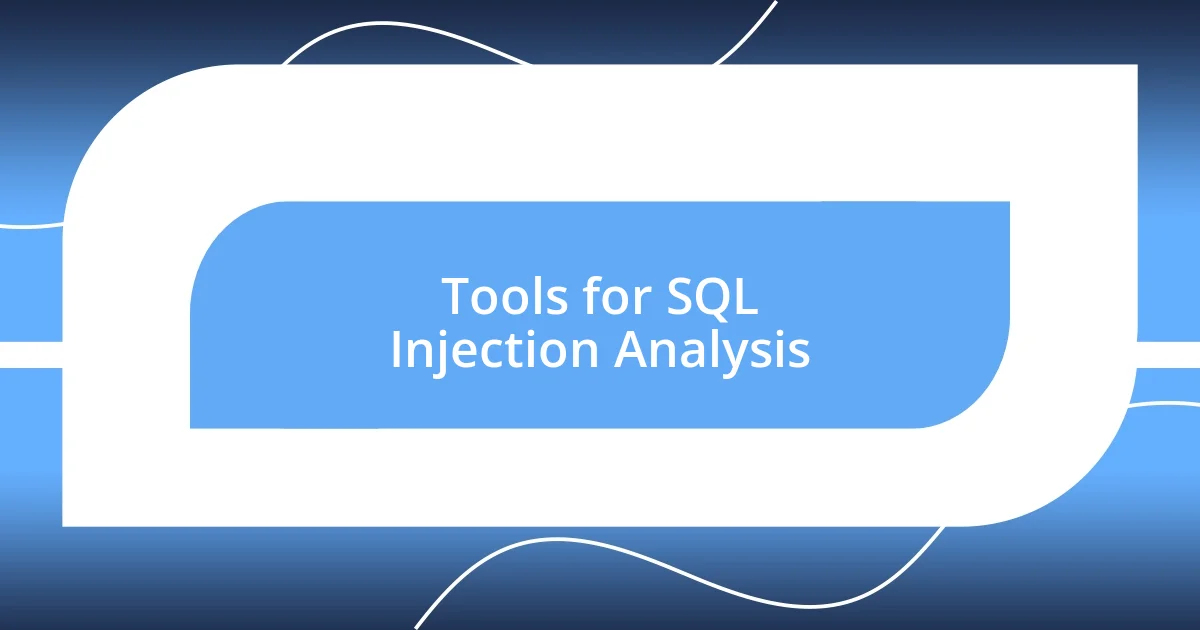
Tools for SQL Injection Analysis
When it comes to analyzing SQL injection vulnerabilities, the right tools can make a world of difference. Over the years, I’ve experimented with various SQL injection analysis tools, each with its own strengths. My first encounter with SQLMap was a revelation; its automated detection capabilities saved me countless hours of manual testing and allowed for a more thorough review of vulnerabilities in my applications. Has it ever struck you how much easier tech can make a daunting task?
Another tool that has significantly contributed to my SQL injection analysis is Burp Suite. I remember feeling empowered the first time I used its suite of tools to intercept and manipulate requests. It’s like having a magnifying glass, allowing me to scrutinize each request sent to the server. This gave me a sense of control in a realm where so much can go wrong. The ability to test real-time interactions truly elevates the analysis process.
For a more basic approach, I’ve found that tools such as SQLQueryStress can be helpful for conducting stress tests on vulnerable input fields. While it’s not specifically an SQL injection tool, it allows me to observe how the application reacts under heavy loads. It often leads to uncovering unintentional exposure points that might otherwise be overlooked. Each tool brings its own unique features to the table, and combining their strengths can create a robust analysis framework.
| Tool | Main Features |
|---|---|
| SQLMap | Automated detection and exploitation of SQL injection vulnerabilities. |
| Burp Suite | Web application security testing with request interception and manipulation. |
| SQLQueryStress | Stress testing input fields to identify performance-related vulnerabilities. |
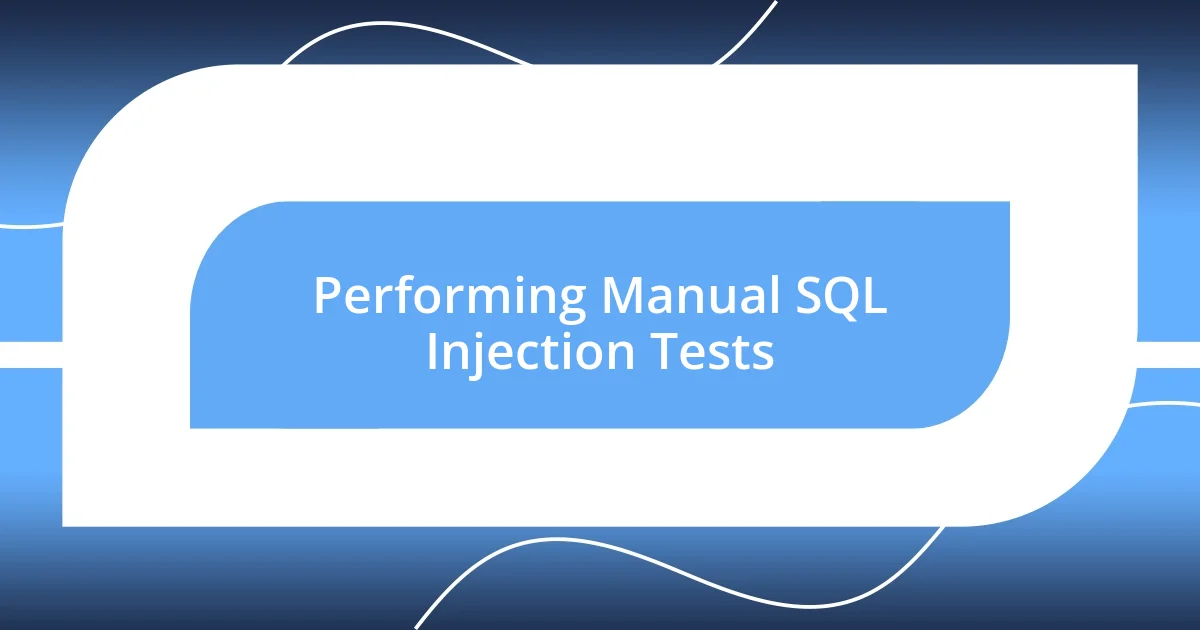
Performing Manual SQL Injection Tests
Performing manual SQL injection tests can feel like solving a complex puzzle. I remember one particular test when I input a simple quote (‘) in a search box, and the resulting error revealed the underlying query structure. It was a rush of adrenaline, realizing how exposure was hidden in plain sight. This incident underscored the value of being resourceful and attentive during such tests.
To ensure thoroughness, I started adopting a systematic approach. By employing a combination of common SQL statements like ‘OR 1=1’ or ‘UNION SELECT’, I observed how the application reacted and if any unauthorized data was revealed. Each test often felt like peeling back layers of security, a bit like unwrapping a gift, only to find more potential vulnerabilities waiting to be exposed. Haven’t you felt that thrill of discovery while digging deeper into a system?
I often found it essential to document every move I made during these tests. Being meticulous about documenting input and response helped identify patterns or flag potential risks for future reference. Reflecting on those notes later, I’d realize that even small, seemingly insignificant inputs could lead to large vulnerabilities. The more I tested, the more I appreciated how manual testing complements automated tools, allowing me to tailor my approach based on the unique behavior of an application. Each instance became not just a test, but a lesson in the never-ending quest for security.
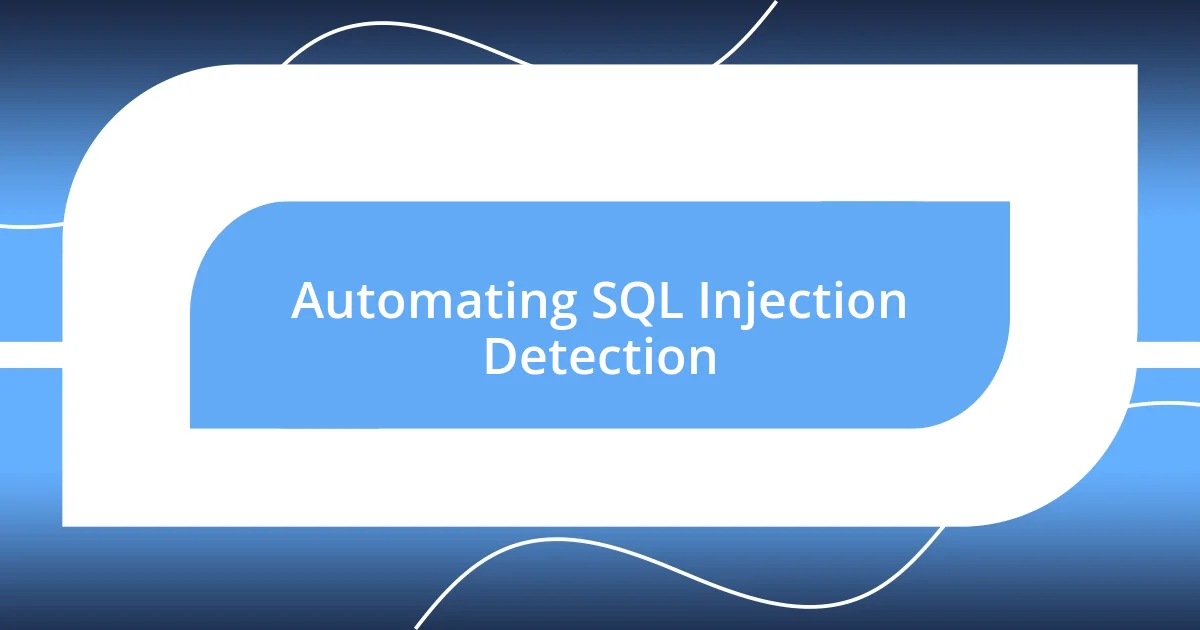
Automating SQL Injection Detection
Automating SQL injection detection has transformed my approach to security analysis. When I first integrated automated tools, I was amazed at how quickly they churned through potential vulnerabilities. It felt like having an extra pair of hands that never tired or missed a detail. Isn’t it fascinating how technology evolves to tackle such challenges?
I remember one project where the application was riddled with potential SQL injection points. Utilizing tools like SQLMap not only streamlined the detection process but also helped me identify patterns across various input fields that I might have overlooked manually. This ability to detect vulnerabilities at scale felt empowering—almost like having a bird’s-eye view of the entire landscape.
Moreover, the interplay between automation and manual testing can’t be understated. When I found anomalies flagged by automated tools, I took it upon myself to delve deeper, often uncovering more intricate vulnerabilities. This dual approach added layers to my analysis, and I truly believe it’s vital—what if a simple automated run misses a critical edge case? Engaging in both methods has been a rewarding journey, constantly reminding me of the importance of vigilance in the field of security.
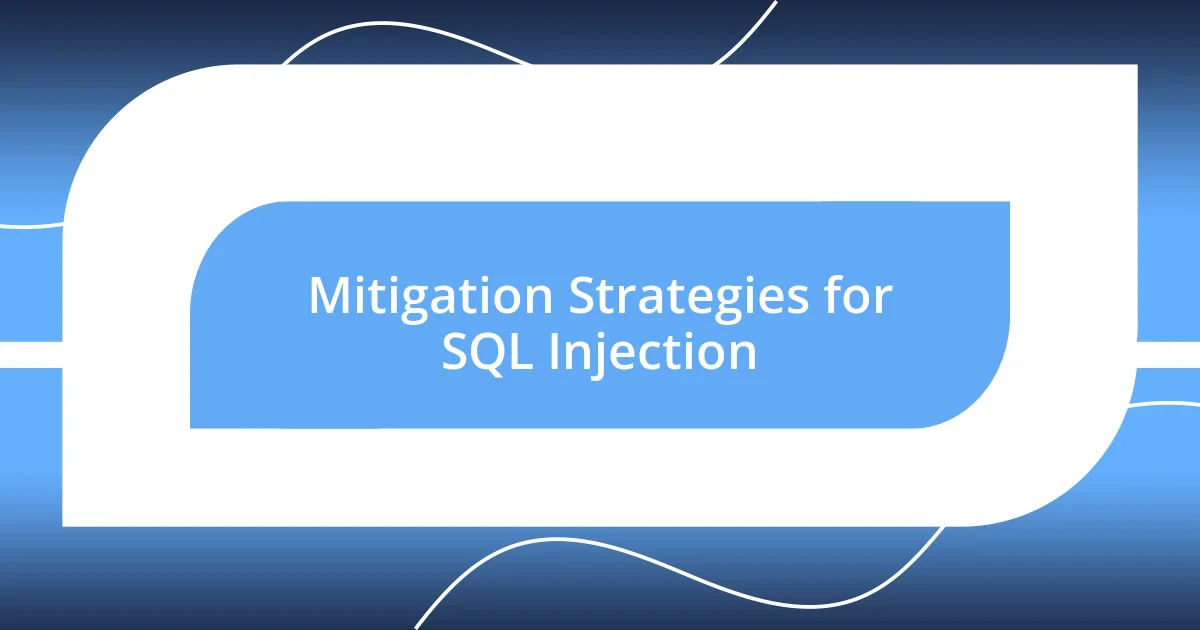
Mitigation Strategies for SQL Injection
Mitigating SQL injection vulnerabilities requires a multi-faceted strategy. From my experience, implementing parameterized queries is one of the most effective ways to prevent such attacks. I remember a time when I advised a team to embrace this practice. They were initially hesitant because it meant reworking existing code, but the peace of mind that came with preventing direct manipulation of SQL queries was well worth the effort.
Another strategy that proved invaluable in my work is regular input validation. I can’t emphasize enough how crucial it is to filter user inputs appropriately. There was an instance where a minor oversight in input handling led to a significant vulnerability. Once we started enforcing strict validation rules, it was like a protective barrier was put in place. I often ask myself: how many potential breaches could have been avoided with this simple step?
Additionally, I strongly advocate for the use of web application firewalls (WAFs). During one critical project, the deployment of a WAF acted as a robust safety net, catching suspicious activity that would have otherwise slipped through unnoticed. Watching the alerts come in, I felt a sense of relief knowing that our application’s defenses were bolstered. It’s a reminder that while we strive for perfect security, layering defenses can significantly reduce the risks. Have you ever experienced that sense of security when you know you have many shields in place?
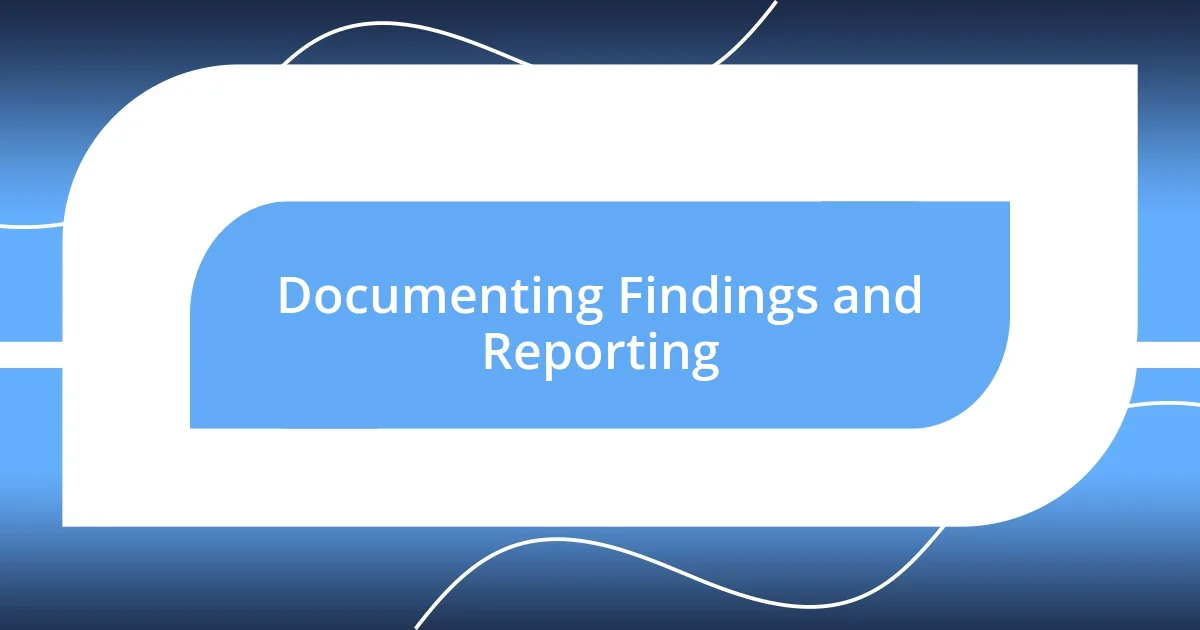
Documenting Findings and Reporting
When it comes to documenting findings from a SQL injection analysis, I’ve learned that clarity is key. I recall a particular assessment where I meticulously detailed each vulnerability I encountered, along with the specific conditions that triggered them. This led to a comprehensive report that not only informed the development team but also became a valuable resource for future audits. How often do we overlook the power of well-documented findings in preventing future incidents?
As I moved forward in my career, I realized that presenting findings is just as important as documenting them. During one presentation, I shared my analysis of a complex SQL injection vulnerability, using visual aids to highlight the attack vectors. The expressions on my colleagues’ faces—a mix of intrigue and concern—reminded me how essential it is to communicate vulnerabilities effectively. Would they have grasped the critical nature of the threat if I hadn’t made it engaging?
Beyond just technical details, I always make sure to advise stakeholders on actionable next steps. In a previous project, where I reported a serious vulnerability, I included specific recommendations for remediation alongside my findings. This proactive approach not only showcased my commitment but also helped the team prioritize their efforts. Isn’t it rewarding when your insights lead to tangible improvements in security practices?












